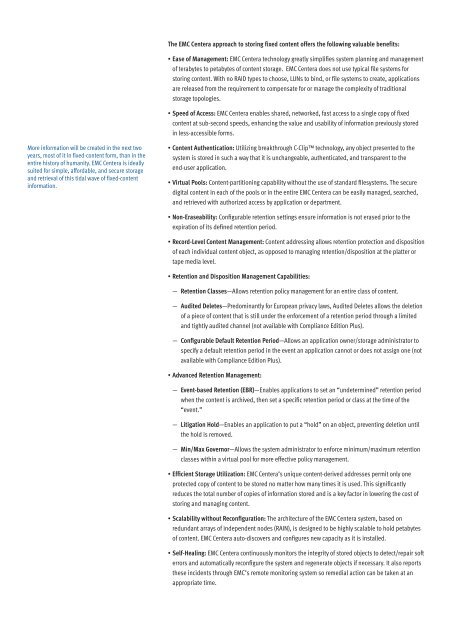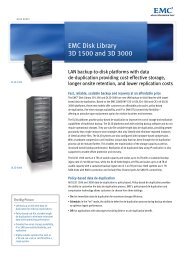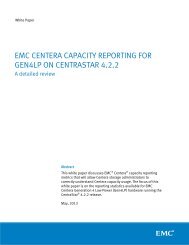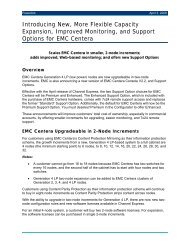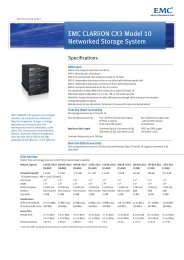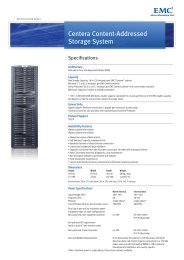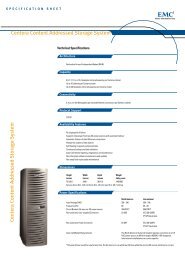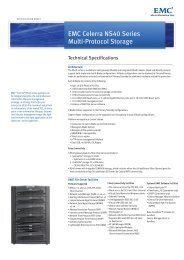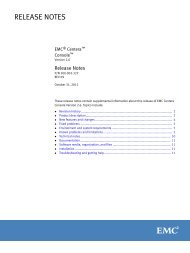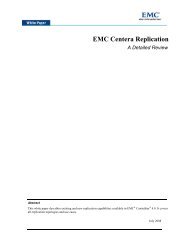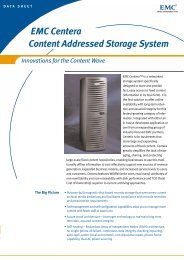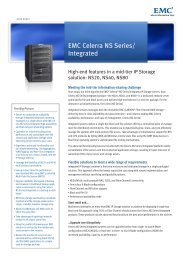EMC Centera Data Sheet
EMC Centera Data Sheet
EMC Centera Data Sheet
Create successful ePaper yourself
Turn your PDF publications into a flip-book with our unique Google optimized e-Paper software.
The <strong>EMC</strong> <strong>Centera</strong> approach to storing fixed content offers the following valuable benefits:<br />
• Ease of Management: <strong>EMC</strong> <strong>Centera</strong> technology greatly simplifies system planning and management<br />
of terabytes to petabytes of content storage. <strong>EMC</strong> <strong>Centera</strong> does not use typical file systems for<br />
storing content. With no RAID types to choose, LUNs to bind, or file systems to create, applications<br />
are released from the requirement to compensate for or manage the complexity of traditional<br />
storage topologies.<br />
• Speed of Access: <strong>EMC</strong> <strong>Centera</strong> enables shared, networked, fast access to a single copy of fixed<br />
content at sub-second speeds, enhancing the value and usability of information previously stored<br />
in less-accessible forms.<br />
More information will be created in the next two<br />
years, most of it in fixed-content form, than in the<br />
entire history of humanity. <strong>EMC</strong> <strong>Centera</strong> is ideally<br />
suited for simple, affordable, and secure storage<br />
and retrieval of this tidal wave of fixed-content<br />
information.<br />
• Content Authentication: Utilizing breakthrough C-Clip technology, any object presented to the<br />
system is stored in such a way that it is unchangeable, authenticated, and transparent to the<br />
end-user application.<br />
• Virtual Pools: Content-partitioning capability without the use of standard filesystems. The secure<br />
digital content in each of the pools or in the entire <strong>EMC</strong> <strong>Centera</strong> can be easily managed, searched,<br />
and retrieved with authorized access by application or department.<br />
• Non-Eraseability: Configurable retention settings ensure information is not erased prior to the<br />
expiration of its defined retention period.<br />
• Record-Level Content Management: Content addressing allows retention protection and disposition<br />
of each individual content object, as opposed to managing retention/disposition at the platter or<br />
tape media level.<br />
• Retention and Disposition Management Capabilities:<br />
— Retention Classes—Allows retention policy management for an entire class of content.<br />
— Audited Deletes—Predominantly for European privacy laws, Audited Deletes allows the deletion<br />
of a piece of content that is still under the enforcement of a retention period through a limited<br />
and tightly audited channel (not available with Compliance Edition Plus).<br />
— Configurable Default Retention Period—Allows an application owner/storage administrator to<br />
specify a default retention period in the event an application cannot or does not assign one (not<br />
available with Compliance Edition Plus).<br />
• Advanced Retention Management:<br />
— Event-based Retention (EBR)—Enables applications to set an “undetermined” retention period<br />
when the content is archived, then set a specific retention period or class at the time of the<br />
“event.”<br />
— Litigation Hold—Enables an application to put a “hold” on an object, preventing deletion until<br />
the hold is removed.<br />
— Min/Max Governor—Allows the system administrator to enforce minimum/maximum retention<br />
classes within a virtual pool for more effective policy management.<br />
• Efficient Storage Utilization: <strong>EMC</strong> <strong>Centera</strong>’s unique content-derived addresses permit only one<br />
protected copy of content to be stored no matter how many times it is used. This significantly<br />
reduces the total number of copies of information stored and is a key factor in lowering the cost of<br />
storing and managing content.<br />
• Scalability without Reconfiguration: The architecture of the <strong>EMC</strong> <strong>Centera</strong> system, based on<br />
redundant arrays of independent nodes (RAIN), is designed to be highly scalable to hold petabytes<br />
of content. <strong>EMC</strong> <strong>Centera</strong> auto-discovers and configures new capacity as it is installed.<br />
• Self-Healing: <strong>EMC</strong> <strong>Centera</strong> continuously monitors the integrity of stored objects to detect/repair soft<br />
errors and automatically reconfigure the system and regenerate objects if necessary. It also reports<br />
these incidents through <strong>EMC</strong>’s remote monitoring system so remedial action can be taken at an<br />
appropriate time.


